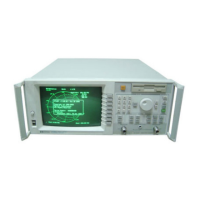I
-
I
-
Using Instrument Functions
Using Markers
To
Use
Other
Marker
Functions
To Use Marker to
Center Frequency
This function changes the analyzer’s center frequency to that of the active
marker and limits the span if necessary. If the markers are all off, and this
function is selected, it first turns on marker 1 at its previous setting or, if no
previous setting, at the center frequency (default).
1. Press (MARKER_) and then use the front panel knob or the numeric keypad
to move the marker to 200 MHz.
2. Press
?QU&BX
Function@
Marker
-->
Gerrtsr and note that the trace
has now shifted and that the center frequency of the analyzer is now
200 MHz.
To Use Marker to
Reference
This function changes the value of the analyzer’s reference level to the
amplitude value of the active marker. This function does not change the
reference position. If the markers are all off, and this function is selected, it
first turns on marker 1 at its previous setting or, if no previous setting, at the
center frequency (default).
1. Press (MARKER_) and then use the front panel knob or the numeric keypad
to move the marker to about -10
dB.
2. Press
Maker
Functions
Marker
->
Ref
ereTtc#
and note that the
trace has now shifted up and that the marker is exactly on the reference
level.
To Use Marker to
Electrical Delay
Press
Marker
F%mctio~~
Marlssr
--)
Else
Delay to add or subtract
enough line length to the receiver input to compensate for the phase slope at
the active marker position. This effectively flattens the phase trace around
the active marker. You can use this to measure the electrical length or
deviation from linear phase. See
ElecWicaJ,
Del&y
in Chapter 9 for more
information.
See “Compensating for Phase Shift in Measurement Setups” in Chapter 5 for
more information on electrical delay.
4-29
-1

